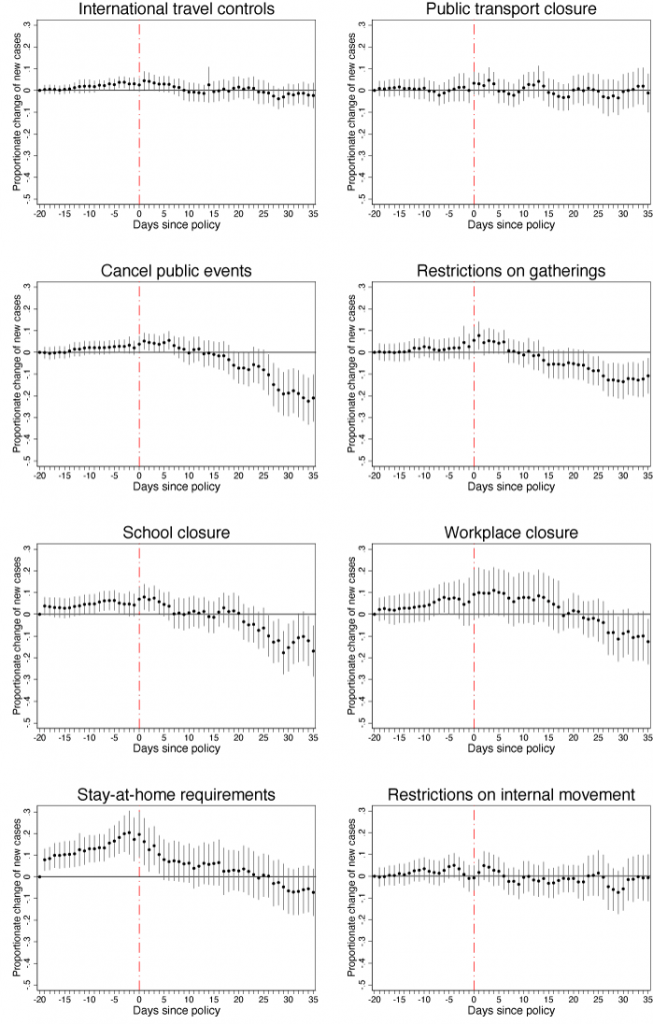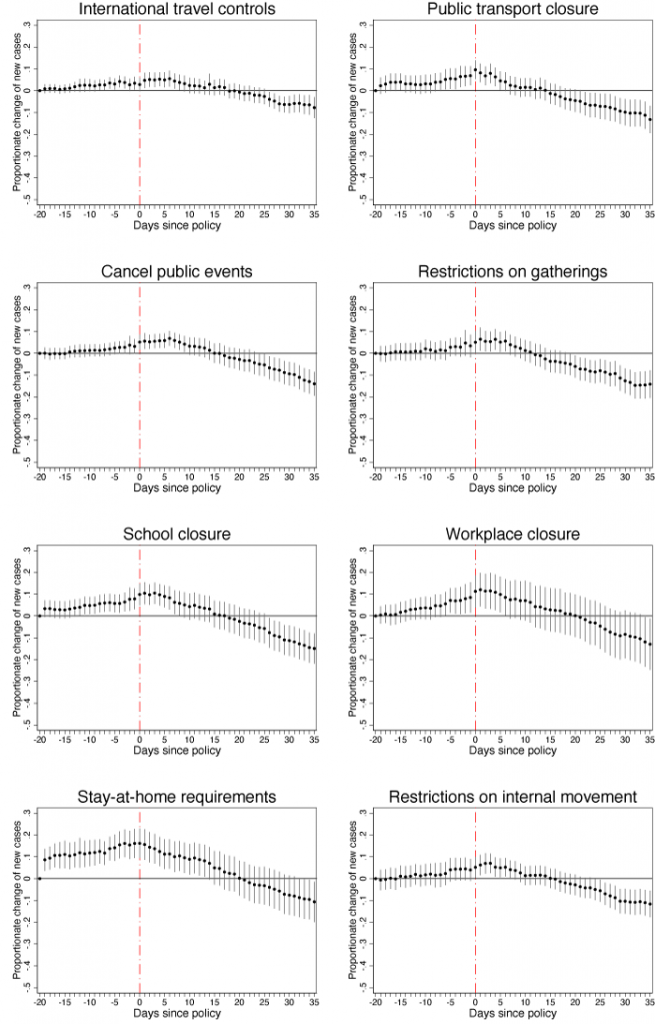In an attempt to mitigate the spread of COVID-19, countries around the world have implemented a number of lockdown policies, which varied in timing and intensity. A recent IZA paper by Nikos Askitas, Konstantinos Tatsiramos and Bertrand Verheyden evaluates the effects of these policies on the daily incidence of COVID-19 and on various population mobility patterns across 135 countries.
The authors use data on non-pharmaceutical interventions collected by the Oxford COVID-19 Government Response Tracker, daily number of infections from the European Centre for Disease Prevention and Control (ECDC), and population mobility data from the Google Community Mobility Reports.
Interventions differ in intensity and timing
They consider eight interventions, which vary in their intensity and timing. The policy responses in focus are: (i) international travel controls, (ii) public transport closures, (iii) cancellation of public events, (iv) restrictions on private gatherings, (v) school closures, (vi) workplace closures, (vii) stay-at-home requirements, and (viii) internal mobility restrictions (across cities and regions).
For each of these policies, the researchers exploit information on the date of introduction as well as qualitative time-varying information on their intensity. Intensity is measured on a scale from one to six, which reflects whether the intervention is (i) recommended, (ii) mandatory with some flexibility, and (iii) mandatory with no flexibility, and whether it is geographically targeted or applied to the entire country.
Mobility patterns show compliance
Policy interventions are also linked to mobility patterns across several types of places such as: (i) retail and recreation, (ii) grocery and pharmacy, (iii) parks, (iv) transit stations, (v) the workplace, and (vi) residential areas. Each of these is characterized by different epidemiological features (e.g. numerosity, density, behavioral norms, epidemiological range, back tracing ability etc.) and, therefore, has a different contagion potential. The mobility data can then be viewed as a measure of compliance to the policies introduced as well as a mediator between policies and the spread of the disease.
The authors develop a multiple-event model to estimate the dynamic effects of each intervention, while taking into account the presence of concurrent interventions. They estimate the net effect of each policy, in the presence of other policies, by exploiting the variation in their intensity over time, and across policies and countries. Accounting for confounding policies is important because it prevents attributing the effect of other interventions to the policy of interest. In addition, it allows to establish that these policies mitigate the spread of the virus by affecting mobility patterns.
Event cancellations and school closures had largest effects
As Figure 1 shows, canceling public events, imposing restrictions on private gatherings, and closing schools have the quantitatively most pronounced effects in reducing the incidence of COVID-19. They are followed by workplace closure and stay-at-home requirements, whose effects are not as pronounced. No effects are found for international travel controls, public transport closures, and restrictions on movements across cities and regions.
Figure 1: Effects of lockdown policies on COVID-19 confirmed new cases with controls for concurrent policies

Data sources: Oxford COVID-19 Government Response Tracker, European CDC and own calculations.
Canceling public events and imposing restrictions on private gatherings start to lower the incidence of COVID-19 about one week after implementation, becoming statistically significant within two weeks. Around the end of the event window (35 days after implementation), a unit increase in the intensity of the policy of interest leads to a 20% decrease in the number of new infections in the case of public events cancellation, and a decrease of about 12% in the case of restrictions on private gatherings.
For school closures, the study finds that new infections start declining a few days after they are closed, with the effect becoming negative and significant about 25 days after implementation. Around the end of the event window, a unit increase in the intensity of school closures leads to about a 15% drop of new infections.
It is worth noting that estimating the effect of each policy while ignoring the contemporaneous influence of multiple interventions would have led to the erroneous conclusion that all policies are effective in reducing new infections. This is shown in Figure 2, which demonstrates the importance of accounting for confounding policies.
Figure 2: Effects of lockdown policies on COVID-19 confirmed new cases without controls for concurrent policies

Data sources: Oxford COVID-19 Government Response Tracker, European CDC and own calculations.
The second part of the analysis links lockdown policies to mobility patterns in order to shed light on the mechanisms through which they help flatten the curve. The study finds that lockdown policies tend to increase time spent at home, and their impact on the incidence of COVID-19 is determined by a number of factors. For instance, canceling public events, and to a lesser extent restricting private gatherings, lower new infections by reducing exposure to numerous and dense locations, where contact tracing is difficult, and can have a large epidemiological range within and across countries (e.g. football games, concerts etc.). Workplace closures, instead, restrict activities away from home but have a lower impact on lowering new infections possibly because of the differences in numerosity, density, behavioral norms, and ability to trace new infections in these environments.
In sum, policies preventing close contacts in large groups, such as public events, private gatherings, and schools are the most effective in reducing new infections. These effects are mediated by changes in population mobility patterns, which are consistent with time-use and epidemiological factors. That travel controls had no impact, although imposed relatively early in many countries, is likely explained by their lack of stringency, allowing the virus to cross borders.
+++
Note: This is a slightly edited version of a VoxEU column written by the authors.
